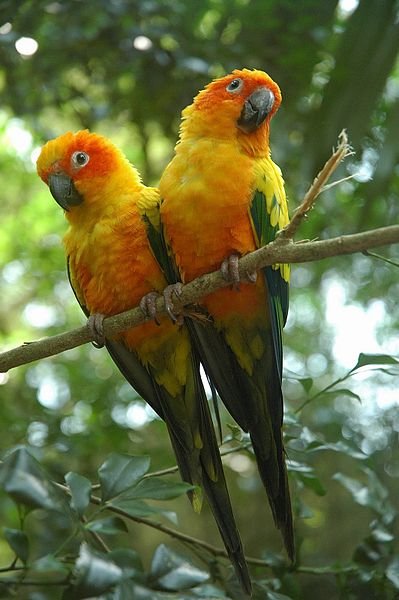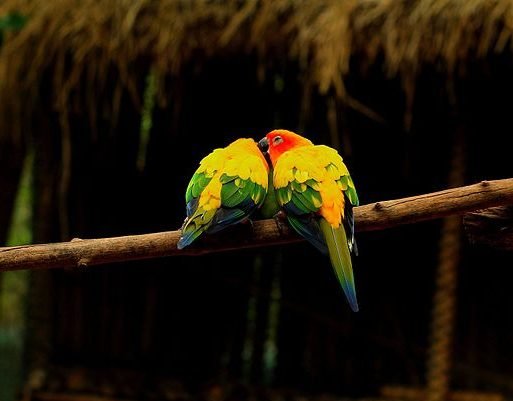Vividly colored birds have always caught the fancy of aviculturists for their demand like hot-cakes. And when we discuss particularly the parrot kingdom, the conure family is ever popular.
The more popular the conure among pet lovers, the higher its demand among breeders. Going by that statistics, the sun conures have beaten all his cousins from the family to be the favorite bird of pet lovers and aviculturists alike.
How are the suns bred? Which season do they usually breed in? Or What breeding behavior they show? Let’s address possibly everything related to the sun conure breeding to understand this species well.
Sun Conure Breeding in the Wild
Living in the open savanna, open forest, seasonally flooded shrubs or the palm groves, the sun conures breeding behavior in the wild hasn’t been recorded much. Believed to be breeding in the rainy season like all the other parrot species, the suns are the cavity dwellers.
Nesting the cavities of the trees, they do not make any effort to build a nest of their own at all. They don’t even mind the narrowest tree cavities to nest inside.
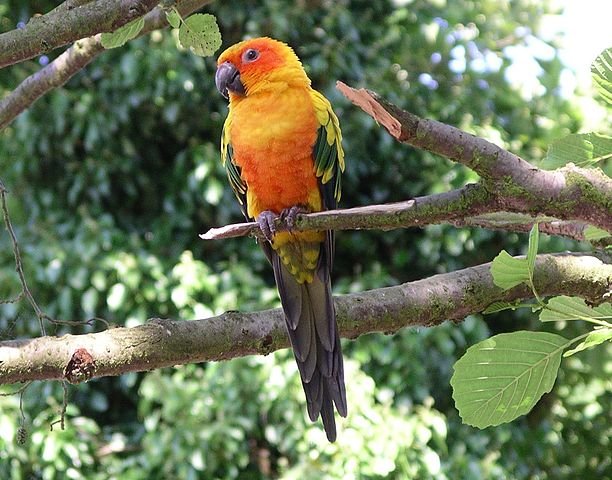
Wayne Deeker / CC BY (https://creativecommons.org/licenses/by/3.0)
Sun conures, like most of the species of the parrot kingdom, are monogamous. Once a bond is developed between a male and a female sun, they prefer to stay together for life. The mating pair likes to feed and preen each other as a form of their expression of love. This grooming and affectionate behavior is on the peak right as the breeding season begins.
The average sun conure clutch size is 3-4 eggs and the eggs are laid one at a time, each after a gap of 1-2 days. Thereafter, the female sun sits on the egg to incubate them. The male rarely sits on the egg, though there is a possibility of him incubating the eggs sometimes albeit for a short duration. The female incubates the egg for almost a month, i.e., around 23-27 days.
After hatching, the young ones stay inside the nest for around 7- 8 weeks and leave the nest only when they are 9-10 weeks old. The newborn sun conure breeding age will be attained at around 1-2 years of age. And the sun conure pair will breed again next year, typically, around February.
Sun Conure Bird Breeding in Captivity
Since becoming famous for their vibrant colors, the breeding of sun conures has got everyone interested. Being a prolific breeding species, they can be easily bred even in a small cage. But the success of the breeding attempt depends on three factors:
- Flight
For successfully fertilizing the eggs, a medium flight is a must for the suns. Hence, the cage size must be made to accommodate the requirement or the birds must be let out on a typical day for some time for flexing their wings to perform well during breeding.
2. Housing
A clean and spacious cage is a must to keep the bird’s movement comfortable. A dirty cage filled with bird droppings and other birds tightly stacked over each other like books on shelves is a big no. Such conditions are stressful for the bird and can result in a failed breeding attempt.
3. Diet
A healthy and balanced sun conure breeding food equals a successful breeding attempt. A perfect mix of seeds, nuts, pellets, fresh fruits, and vegetables are a necessity for breeding pair. This is because they have a complete profile of all the minerals, vitamins and proteins required by the breeding suns. For eg., a calcium-deficient diet will result in egg-shells breaking off before hatching.
How to select a breeding pair?
The first prerequisite for breeding is having a male and a female sun conure. Before adopting the suns, one can get them surgically sexed or DNA tested to be sure about their gender. Once it has been established, the next step is developing a bond between them.
Since sun conures mates for life, they take their time to form a bond with a mate. Though suns aren’t much fussy like some other parrot species about selecting their mates, a male and female sun caged together don’t need to certainly mate one day. They might or might not form a bond. To avoid this probability, one can always go for a safer alternative, i.e., choosing a bonded or proven pair.
What is a bonded pair? A bonded sun pair is the one that has already shown interest in each other by feeding each other. One can visit a breeder and specifically adopt a bonded pair. It is easy to breed such a pair as the pair will immediately mate once the breeding season starts. Also, the male helps the female sun in incubating the eggs and raising the chicks.
What is a proven pair? A proven pair is the one that has already produced chicks previously and hence already shares an affectionate bond. One doesn’t have to wait for them to bond or breed when the season comes. A proven pair can easily be bought from a reputed bird breeder.
Once a bonded or proven pair has been adopted, all one needs to do is cage the pair together in a breeding cage separate from other adopted birds, if any. The reason for their isolation is that the breeding suns can become territorial sometimes due to hormonal changes.
Sun Conure Breeding Equipment
If one is breeding a sun conure pair, he must always have a piece of breeding equipment handy irrespective of the fact if the birds are incubating or rearing the chicks or not. This is to cover up for any failure on the part of the bird’s incubation process and not let that result in an unsuccessful breeding attempt.
Incubator
Though expensive equipment, it is of great help if the suns decide to abandon the clutch during the incubation period. Also, if one decides to remove the eggs as soon as a clutch is laid and wants to incubate artificially, it would be possible with an incubator.
Brooder
Sometimes the chicks are removed as soon as they hatch to be hand-raised. In such a case, their body temperature needs to be regulated artificially to keep them safe. Hence, a brooder is a must. After they have acquired their plumage, they will be fine by themselves thereon.
Leg Bands
Many reputed bird breeders running sun conure breeding farm put aluminum or stainless steel rings around the sun conure chick’s legs when they are merely around 2 weeks old. With 6.5mm of internal diameter, these rings are also popularly known as leg bands and lend credibility to the breeder.
The reason behind this reputation is that these bands guarantee a complete record of the birth almost from the day he was born. While adopting, the buyers can ask for any information related to the bird’s history. All the breeder has to do is look up the number on the leg band and take out the related file kept in records. Most of the owners prefer to adopt banded birds these days.
Sun Conure Breeding Cage Setup
Setting up an environment for the sun conure pair to breed comfortably is extremely important. And that environment primarily is the cage for these birds. Ideally, a cage size of 48 inches in length and 24 inches in width and height is important as the pair can take flights easily to increase vitality and fertility along with keeping stress at bay.
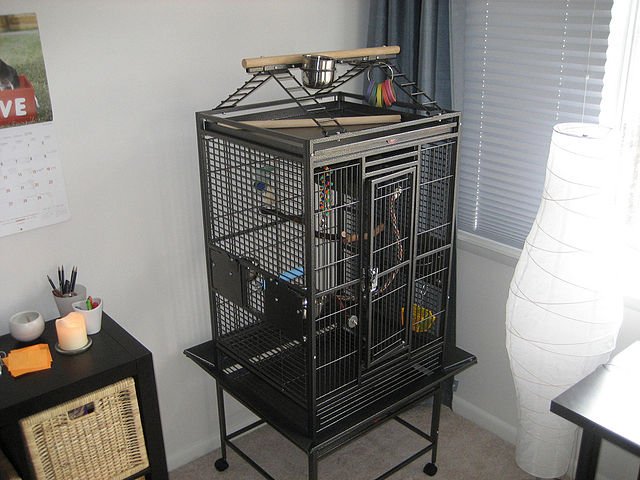
The breeders running sun conure breeding aviary keep all the birds together in large cages. In such cases, it is better to shift the breeding pair to a small or medium-sized cage before the breeding season begins as the new pair will take time to adjust to staying alone with each other and get comfortable in the new environment before mating.
Sun Conure Breeding in a Nest Box
While in the wild, the sun conures nest in small cavities of trees and this is the ‘sun conure breeding setup’ they are naturally inclined to for successful breeding.
Hence, a mated pair can be caged together for breeding but the pair will not breed until the conditions are conducive. The thing that they would need to breed is a small tree-cavity and to replicate this, a nest box serves the purpose well.
A wooden nest box is the best alternative to a nest in the wild, along with the additional benefits of being organic and warm to help in incubation and keeping the chicks warm. A sun conure nest box size of around 12 inches in length, width, and height. It can be attached to the outside of the sun’s main cage by allowing a small opening from inside. Lining the cage with a natural material like wood shavings or old newspaper would add extra warmth to the box and prevent the eggs from rolling off and getting damaged.
Breeding Process in Sun Conures
Sun conures produce a minimum of two clutches in a year with each clutch having 3-5 eggs. Some sun pairs can even produce more than two clutches but the practice must be discouraged to keep the bird’s health optimal and prevent them from becoming nutrient-deficient.
To do so, the best way is to remove the nest box joined by the side of their cage. But it must be replaced with a bird tent since suns love to snuggle up in a cozy place throughout the year.
Sun Conure Breeding Diet
Just like humans, diet plays an important role in the reproduction process of birds too. With each stage of reproduction, the dietary needs of the sun conure also change.
Diet to induce breeding
It may sound odd to the beginners, but the regular bird lovers know that diet can be used to encourage the birds to breed. If followed religiously, a special diet may make the birds nest together and breed.
- The first step is to start feeding the matured birds a diet comprised solely of balanced seed mix around 2- 3 months before the breeding season begins, say, around November as they breed around February. Feed the pair this diet strictly for around 6-8 weeks. This diet will thwart the breeding behavior and put them off first.
- Now after the 8th week, change their diet abruptly by replacing it with fresh fruits and vegetables to make their hormones tickle. For morning feed, offer them chopped fruits and vegetables like raw peas, apples, grapes, corn, steamed sweet potatoes or carrots. To prevent the bird from getting bored, add a very small amount of soaked seeds and pulses like sunflower, safflower, lentils, etc. An occasional piece of bread, pasta or rice can also be served. For afternoon feed, add some pellets to keep the bird interested.
- Keeping them on this diet will encourage the birds to nest. Do not change the diet further till they nest as it may disrupt their breeding behavior. Make sure to provide them the appropriate nest box as explained above.
Diet during Breeding
Feeding a balanced diet, especially to the hen, during breeding period ensures healthy chicks when they hatch. The sun conure breeding diet must be a perfect mix of all the vitamins, minerals, proteins and calcium. After the chicks are hatches, they can be fed healthy foods like corn cobs, peas, sprouted seeds, or apples which the parent suns will regurgitate to their young ones.
Sun Conure Breeding Behavior
Like most of the parrot species, the sun conure pair also gets affectionate towards each other when they are ready to mate. They will feed each other and groom each other. The pair would love to get cuddly all the time and would stay together all day long.
Sun Conure Breeding Problems
Like other parrots, even the suns aren’t immune to the problems during the breeding period. A sun pair might or might not face any problem, it all depends on the pair. Here’s a list of some of the most common breeding problems:
Egg abandoning
Some sun conures tend to abandon their eggs after laying and prefer not to incubate them for hatching. The reason could be that the birds are inexperienced for being hand-raised or they aren’t comfortable in their cage or they fear to lose their nest box and start guarding it as soon as they lay eggs. In any case, eggs must be removed immediately either to be incubated by experienced sun pair or artificially in an incubator.
Egg Breaking or Eating
In a bid to protect their eggs from their breeder/owner, some suns might end up eating their eggs or breaking them by jumping on it. This happens when the birds haven’t formed any bond with the breeder. Also, sometimes the bird might accidentally break the egg. If that has become a norm with the sun pair, it is better to remove the eggs from the nest as soon as they are laid and incubate them artificially.
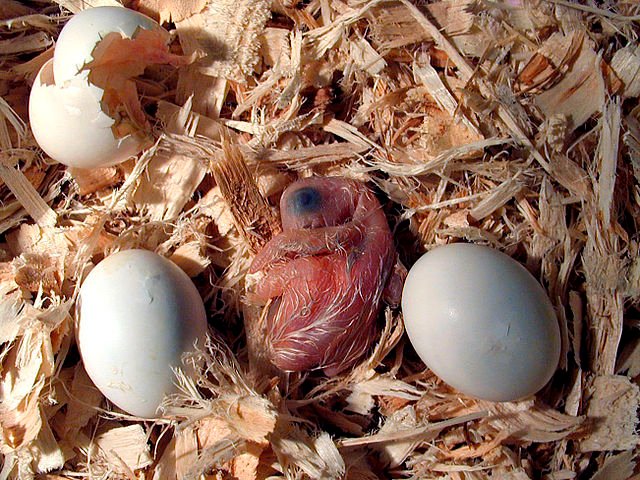
Egg binding
Being one of the most common problems in breeding hens, egg-binding is caused due to the hen being deficient in calcium. To avoid this problem, the hen must be provided with enough calcium in her diet required for making egg-shells and for keeping her bones strong. Cuttlebone is the favorite of these birds. Mineral blocks are the next best option. If ignored for long, the hen may contract arthritis and will also be unable to lay eggs.
Mate aggression
Mate aggression during breeding season is always the biggest problem to tackle for the breeder and the birds themselves. Out of the sun pair, the male is the aggressive one. So much so that the stress can sometimes kill the youngest chicks due to lack of care and attention in a stressful environment. Though this aggression is a result of hormonal changes during breeding, the breeder can try to reduce the aggression to a minimum by following ways:
- Provide the birds with some toys to keep their mind relaxed with mental stimulation. Other such means of entertaining the birds can also be used.
- Provide ample space to the pair for movement as clutter makes the male sun aggressive. Sharing space with other birds can also lead to territorial aggression in him.
- Keep the bird’s environment noise-free as it makes the male irritable. The noise of other pets like cats or dogs can stress out the male sun.
How to Solve Breeding Problems
The breeding problems will crop up almost every breeding season with most of the sun pairs. So it is better to become adept at addressing them than avoiding them.
- In the case of the male aggression issue, one can separate the cage of the male by shifting him to another cage for a while. When the male seems to have calmed down after a few days, put him in a separate cage next to the female sun’s cage and if he does not snap again, put him back with his mate.
- If one is thinking of adopting a proven sun conure pair, he must check his past aggressive behavior. If he has ever killed or harmed his mate in aggression, he must not be made a part of the breeding program.
- One of the easiest ways to tackle breeding problems in sun conures is keeping them in large cages where they can take short to medium flights in a day. This keeps the bird relaxed. Accommodating the pair in a big cage has been proved to improve the success rate of breeding attempts.
- Diet plays an important role in regulating a bird’s hormonal changes properly, thereby, reducing the aggression and irritation in them. Give them a balanced diet to keep them relaxed.
- Sun conures in the wild hardly show any breeding behavior as boredom never bothers them. But in captivity, they don’t have much to do and feel frustrated alone. Providing enough entertainment sources for the suns can help in keeping their aggression during the breeding time to the minimum.
- Clipping the male sun’s wings is another way to protect the chicks and the hen from male aggression. Though this must not be tried in all cases and should be used as a last resort to prevent the female from getting physically attacked by an extremely aggressive male sun.
- Lastly, always try to let the birds choose their mates by spending time with each other. Otherwise, if the pairing seems immediate on the breeders part, try to pair aggressive males with aggressive hens and vice versa.
Read About Raising Sun Conure Baby :
https://parrotquaker.com/raising-sun-conure-baby/
Summing Up
Least bothered by their infamous noisy behavior, the popularity of sun conures dare not die down. As long as the bird lovers keep demanding for more, the sun conure bird breeders will breed these vibrant-looking and lively birds. And they aren’t even shying away from cross-breeding them. The most famous sun conure crossbreed has been a Sunday, i.e., an off-spring from a sun conure and a jenday.
But the question is that does sun conure crossbreed naturally? The most apparent answer to this is ‘no’. And whenever anyone has tried to crossbreed suns with other conure species say, an attempt of sun conure and green cheek conure breeding, it has led to a sad end of the off-spring, not surviving until adulthood or leading a sick and painful life for a few years.
So, adopting a pure sun conure species for petting is best as it is easy to care for them. Additionally, if one intends to breed them in the future, know all the possible things for successful breeding. Lastly, more than anything else, it is always important that the birds are comfortable breeding or mating and shouldn’t feel stressed in the process. Only happy parents will give birth to healthy chicks.
Check what are best toys for sun conure
Read about Pineapple Variation:
https://parrotquaker.com/all-about-pineapple-conure/

